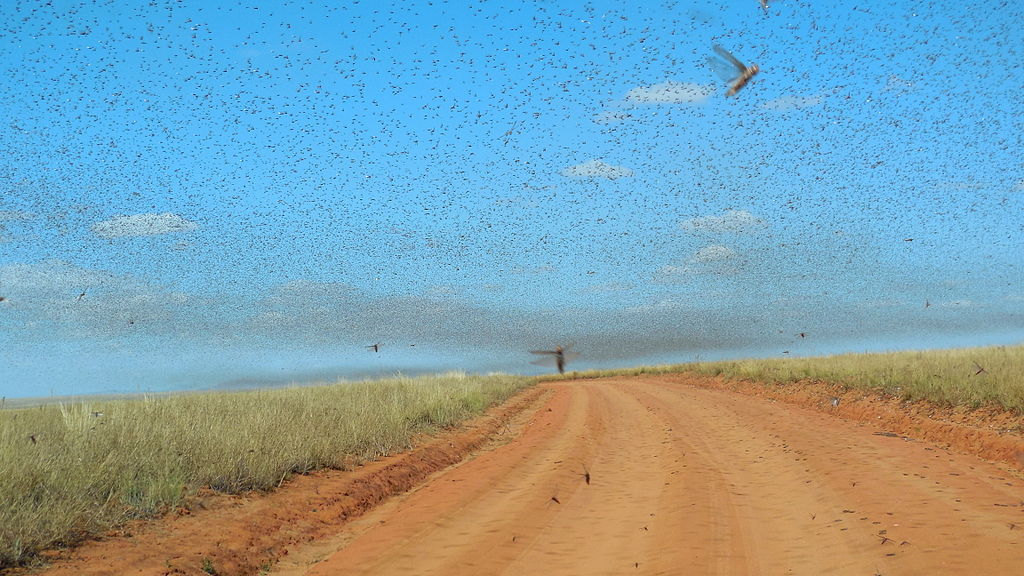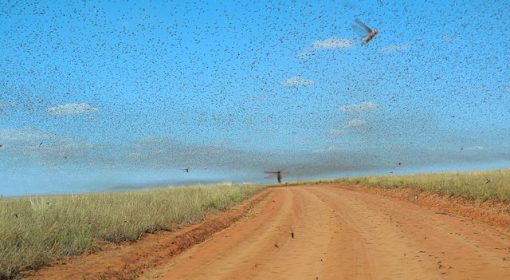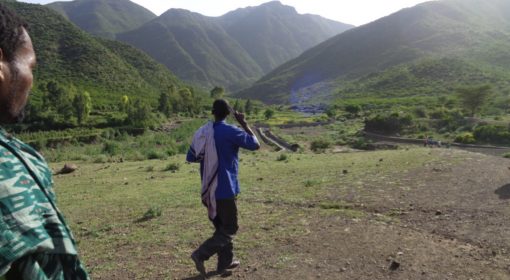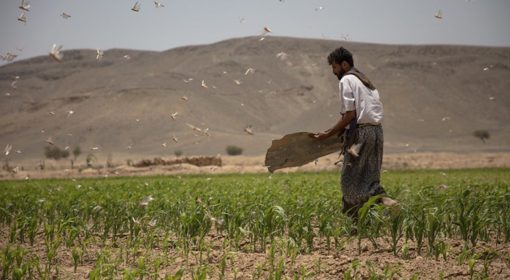Locust threat averted in Sindh, Pakistan
By Gulsher Panhwer, Research and Development Foundation (RDF), Flood Based Livelihoods Network (FBLN ) Pakistan chapter, contact: gulsherp@yahoo.com
A swarm of locusts. Image Courtesy Wikimedia. Source: https://commons.wikimedia.org/wiki/File:Swarm_of_Locusts.JPG
Locust, a short-horned grasshopper in the family of Acrididae, is not new to Pakistan. It caused devastation to Pakistani agriculture in 1950s, 1960s and 1990s. In response to take measures to avert locust threats in Karachi metropolis, the provincial Minster for Agriculture suggested to astounded Karachi denizens to make good biryani out of locust.
Earlier reports this year expressed fear in June over the arrival of locusts. Some claimed locust came from Iran, others held the view that the insects flew from India. Before reaching Sindh provincial capital, the large swaths of locusts played havoc with the lush green organic crops in Tharparkar and Sanghar Districts as well as other adjoining areas of Sindh.
Social media was also awash with similar remedies of getting rid of these insects by resorting to feasting on them instead. But this solution of decreasing the large swaths of locusts by eating was in practice when agriculture science had not developed and was practiced on outdated methods. A solution to the locust threat by frying and eating them was and is just a myth. Is it humanly possible for few people to catch million flying insects? The fumigation came as second thought or as last resort for authorities. And what would the use of the insect killing spray be when insects have already caused irreversible damage. After causing avoidable damage to crops and natural fauna in Thar and other eastern parts of Sindh and in Memon Goth in Karachi, on November 16, 2019, large flocks of locust entered in the vicinity of Dadu Distract.
The farmers are worried. Large tracts of prime land have remained barren for last three decades due to acute shortage of water in barrage areas and equally orphaned spate irrigation in semi desert Kachho area spreading over 40,000 hectares. However, due to mismanagement and neglect its potential is not fully realized. But nature became benevolent this year:good rains and successive high flows of Nai Gaj and other smaller streams brought Kachho into life and large parts of highly fertile land were brought under cultivation.
Widespread organic crops’ cultivation have checked mass migration and kindled hopes for better times for drought affected farmers, but untimely rain and impending threat of Locust has put the future of famers under high risk of losing billions of rupees invested in growing crops. Related authorities might have taken the precautionary measure when locust was flocking from India or when they have entered Tharparkar. But nothing moved them. Research and Development Foundation (RDF), a Hyderabad, Sindh based nongovernmental organization works in different districts of Sindh, on agriculture, water and Education, educated farmers to cope with locust threat. Mr Ashafaqe Soomro, Executive Director, RDF, said that controlling locust through spray has negative impact on environment and other modern and local methods to control the locust threat should be applied. The preventive measures suggested to farmers in Tharparkar by RDF team included digging 1/2 feet ditches around field, collecting locust at night using flashlight, and driving away locust by making noise using different tools.
After getting news of the impending arrival locusts, the RDF team in Dadu district contacted the local extension department, got information on prevention measures, and shared it with farmers and leaders through Whatsapp, Facebook and phone text messages. Ali Nawaz Kalhoro, Deputy Director, Agriculture Extension Department shared that “Locust jumping nymphs in Islamkot Tharparkar will soon migrate to west after becoming full winged adults. It should be noted that overlapping generations are scattered in Thar areas of Sindh, Punjab and India. Now they are in dangerous mode. Hopefully it is time for grasshoppers to migrate towards west. Growers are advised to be vigilant and try to drive out the locust flock with some devices like beating empty tin boxes to fly these away from the crops and be alert until the threat is completely averted.”
It is rightly said that need is mother of invention.
“When locusts attacked standing crops, trees and shrubs in the areas of Chachro, Dahli, Nagarparkar in Tharparkar, the locals used preventive measures like putting stones in empty plastic bottles and shook them repeatedly. This noise made the insect fly away” wrote Manoj Geani from Tharparkar. Other measures adopted by the farmers included beating tin cannisters and creating smoke. Local farmers say that evenings are a favourable reproduction time for these insects. Female locusts laying eggs causes small holes in the ground. According to local farmers from Tharparkar and Sanghar, concerned government departments have started preventive fumigation in some areas but there too spray ingproved ineffective in completely driving away the locust. Locals from Tharparkar rubbished the news of eating locust, they said that even their livestock does not like to eat the fodder or grass touched by locusts as the insects left behind unfavourable smell.
When this winter a Thari famer was asked about his comment on locust attack, he tearfully said that the locust destroyed his 2 acre crop and completely wiped the only source of his livelihood. Ali Akbar Rahimoo, a social and political activist from Umerkot, while sharing his views with this scribe, took the issue head-on. “The Pakistan Calamity Act enacted in 1958 has become outdated and does not meet the needs of present.” He added that 1950s onwards the nature of the climate has been different. “Now after climate change era we have entered a phase of climate strikes. Attack of locusts should be taken as calamity and National Calamity Act should be amended with inclusion of climate strike scenario.” Rahimoo further stated that “for the first time heavy rains were experienced in November across the Tharparkar desert and this provided favourable environment for locust growth and resulted in the worst locust attack”. He said that in the past, scattered rain resulted in scattered crop cultivation. When locust arrived, they were driven away by farmers, and on not finding standing crops nearby they would perish. But this time as whole Thar land was sprouting lush green crops and shrubs, making for conditions conducive to survival, growth and multiplying of locusts.
In the past, at the stage when locusts’ larvae (who could not fly but only crawl) were visible in small number, farmers just dug ditches, drove the larvae to fall into them, and covered them with soil. However, the intensity of the outbreak and the sheer number of locusts was so much that this coping mechanism was not adequate.
If climate change turning into climate strike has high potential to shrink and destroy natural resources and livelihood sources, then modern technology and information explosion has created high potential to cope with these challenges and help in mitigating its destructive impacts. The killing of 29 people and hundreds of livestock by lightening in Tharparkar and damage caused by locusts to farmers’ livelihood might had been averted or mitigated if affordable anti-lightning strike instruments had been installed and spraying had been done from helicopters. However, one hopes against hope that from legislators to officialdom and from researchers to non-governmental organisations, everybody will join hands to make sincere and concerted efforts to amend the calamity act (so that it includes lightening and locust threats), and researching alternate environmental friendly coping methods applied in other countries. Another important step will be empowering and reinvigorating national, provincial and district-level Disaster Management Authorities, agriculture extension departments, plant protection department and host of other related institutions to undertake action research and help mitigate such calamities if not avert them fully.
A slightly different version of this article was originally published at https://dailytimes.com.pk/504634/locust-threat-in-sindh/





